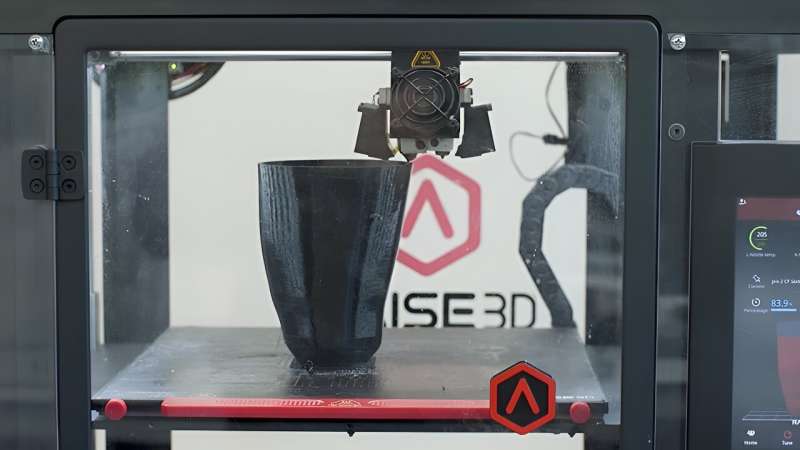This article has been reviewed according to Science X's editorial process and policies. Editors have highlighted the following attributes while ensuring the content's credibility:
fact-checked
trusted source
proofread
Breakthrough in 3D printing could enable access to personalized prosthetic devices anywhere in the world

Lower limb prosthetic sockets could soon be printed in remote locations and even in users' homes, thanks to a groundbreaking process developed by manufacturing experts at Loughborough University.
Dr. Simin Li, a Senior Lecturer in Mechanics of Biomaterials in the School of Mechanical, Electrical and Manufacturing Engineering, has pioneered a fully digital design-to-manufacturing process that has the potential to revolutionize lower limb socket production by allowing printing outside of hospital settings.
Traditionally, the creation of a lower limb socket has been a time-consuming process, taking around 3–6 weeks.
The method involves taking a cast of the limb, which serves as a mold for crafting a socket. The process necessitates visits to hospitals, relies heavily on labor-intensive skills and expertise, and often involves a trial-and-error approach.
The resulting sockets, according to Dr. Li, are more akin to "works of art than medical devices" and can lead to skin and stability issues if they do not provide a perfect fit.
This process also has to be repeated frequently as sockets wear down quickly with use. They are replaced every 3–6 months for adults and even more regularly for children.
Dr. Li's revolutionary method utilizes a variety of technologies and unique coding to create a socket through a fully digital process.
By capturing a 3D scan of the user's limb with a digital scanner and employing computer-aided design (CAD) software, a personalized design profile is generated, which can be imported into a 3D printer for manufacturing.
The result is a fully customized socket that can be produced in as little as eight hours, making the process significantly faster than current methods.
What is unique about Dr. Li's method is its potential to enable 3D printing of sockets in remote locations and even in users' homes.
The digital scanning and 3D printing facilities can be deployed to different areas, including under-served regions and developing countries with limited access to health care.
Lower limb prosthetic users could scan their limb, send the scan to a health care expert who can process the design remotely, and receive a customized design file in return.
This file can then be used to conveniently print a socket in the user's location, overcoming geographical barriers and transforming the way personalized medical devices are accessed and produced.
Dr. Li said, "By using a fully digital design-to-manufacturing workflow and additive manufacturing—or '3D printing' as it's commonly known—our entire process for creating a socket is quantitative and iterative, therefore, highly customizable, repeatable, and efficient.
"By using the innovative digital solution, health care professionals can focus more of their valuable time with users and therefore, increase the accessibility for all and on-demand.
"The ultimate goal for this project is to make the design and manufacturing process easier and more accessible for both the health care professionals and users so that one day the prosthetic socket can be manufactured on demand in local community areas, hospitals and even in users' homes."
Dr. Li and team have optimized their 3D printed socket designs through extensive testing in their in-house developed facilities, which involves subjecting printed prototypes to loads ranging from 6,000 to 16,000 Newtons, equivalent to seven-to-20 times of body weight, depending on the user.
The team's technique also allows them to increase design freedoms, meaning they can make regions on the socket harder or softer depending on the user's needs, which Dr. Li hopes will improve comfort and further facilitate participation in play, physical activity, and sports.
Their next step is to collaborate with academic and industrial partners to transform their 3D-printed socket prototypes into real-world products and explore the application of their process in diverse settings.
Dr. Li said, "I hope to see this research one day benefiting lower limb prosthetic users worldwide and kick-start broader discussions about using 3D printing for medical devices and beyond.
"Currently, the entry barriers for accessing health care facilities, medical professionals, and 3D printing techniques in remote locations is too high.
"We believe our research will not only breakdown these barriers, but act as a catalyst for other exciting innovations that utilize 3D printing."
Paratriathlete Finley Jakes, a lower limb prosthetic user, and a recent Loughborough University graduate, visited Dr. Li and team to hear more about their research.
Finley—who is a member of the British Triathlon Paralympic World Class Program and has represented and medalled for Great Britain at events around the world—told the researchers it usually takes around a month for him to receive a socket and that he has experienced skin issues as the result of wearing poorly fitted sockets.
He said, "I think this research could benefit so many people, especially children growing up that need sockets readily available. It has huge potential."
The findings are published in the Journal of Materials Research and Technology.
More information: Theodoros Marinopoulos et al, Structural integrity of 3D-printed prosthetic sockets: Experimental study for paediatric applications, Journal of Materials Research and Technology (2023). DOI: 10.1016/j.jmrt.2023.03.192





















